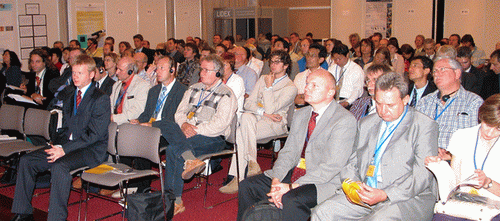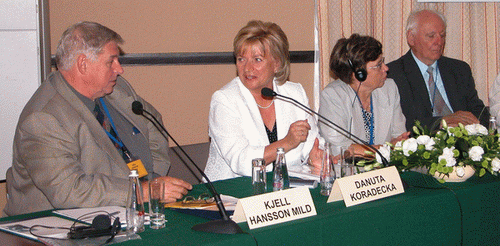|
|
Site under reconstruction, please come back soon.
Exposure of workers to electromagnetic fields (EMF) and sources od EMF are presented at: wypadek.pl

TEST-PRO-SAFETY-LIFE

EMF-NET

|
Electromagnetic fields in the workplace
The use of some types of EMF sources causes significant exposure of workers, mainly among health care staff and industrial workers. The occupational exposure characteristics are different from that of the general public - higher level, longer durations per day, shorter distance of the human body from the EMF source, higher frequency and modulation complexity, and there is often simultaneous exposure to various chemical and physical agents. In comparison with the mobile-phone's exposere, occupational EMF topics are relativelly weakly represented among scientific activities. They have recently become to be of high prioryty because of the implementation of the European Directive on occupational EMF exposure limitation. A part of this work carried out within European Framework Programes was presented at The International Workshop on Electromagnetic Fields in the Workplace.
International Workshop ( September 5–7, 2005, in Warszawa, Poland)
The event was organised by the Central Institute for Labour Protection – National Research Institute (CIOP-PIB) as the final activity of the Centre for Testing and Measurements for Improvement of Safety of Products and Working Life (TEST-PRO-SAFETY-LIFE) project (2002–2005), carried out within the 5th Framework Programme of the European Commission. It was co-organised by the Coordination Action EMF-NET Effects of the Exposure to Electromagnetic Fields: from Science to Public Health and Safer Workplace (2004–2008), carried out within the 6th Framework Programme, with the international patronage of International Union of Radio Science (URSI) and European Agency for Safety and Health at Work. It was attended by over 150 participants from 18 countries (Austria, Belgium, Bulgaria, Croatia, Finland, France, Germany, Italy, Japan, Luxembourg, Netherlands, Poland, Romania, Slovenia, Spain, Sweden, Turkey, UK) (pic. 1). The workshop was prepared by International Program Committee [Danuta Koradecka, CIOP-PIB, Poland (chair person); Maila Hietanen, FIOH, Finland (vice-chair person); Kjell Hansson Mild, NIWL, Sweden (vice-chair person); Gilbert Decat, VITO, Belgium; Rosaria Falsaperla, ISPESL, Italy; Krzysztof Gryz, CIOP-PIB, Poland; Jolanta Karpowicz, CIOP-PIB, Poland; Paolo Rossi, ISPESL, Italy; Monica Sandström, NIWL, Sweden] and Organising Committee (CIOP-PIB) [Daniel Podgórski (chair person); Jolanta Karpowicz (vice-chair person); Krzysztof Gryz; Dorota Bielecka; Katarzyna Buszkiewicz; Marcin Molenda; Dariusz Pleban; Agnieszka Wolska; Patryk Zradziński].
The main purpose of the workshop was to update knowledge related to electromagnetic hazards in the workplace and methods of electromagnetic risk evaluation and reduction. The workshop was focused on occupational exposure assessment methods, as well as the state of the art in bioelectromagnetic research and computer dosimetry. During 3 days meeting, 39 talks and 17 posters were presented. Additionally the round table discussion were organized. The key presentations were provided by invited experts, i.e.: Paolo Vecchia (Italy) – chairman and Maila Hietanen (Finland) – vice-chairman of International Commission on Non Ionising Radiation Protection (ICNIRP), Norbert Leitgeb (Austria), chairman of European Action COST 281 – Potential Health Implications from Mobile Telecommunication Systems, Georges Herbillon (Luxembourg) representative of European Commission, Dg Employment, Kjell Hansson Mild (Sweden), Philip Chadwick (UK), Wojciech Gwarek (Poland), Stanisław Szmigielski (Poland) (pic. 2 and 3). Current national discussions on the implementation of European Directive 2004/40/EC, concerning the safety requirements for workers exposed to EMFs, indicate wide international interest in the topics presented during the workshop.
During the Workshop were presented i.e.: the basic principles of workers protection against excessive EMF exposure adopted by ICNIRP, European Directive 2004/40/EC and legal system for occupational safety and health regulations established in Poland. The possible application of the precautionary measures to the general rules for workers protection was discussed as well as the question about the consequences of new scientific data referring to the electric current perception for the levels of acceptable EMF exposure of low and medium frequencies. EMF measurement methods applicable for the worker's exposure assessment were presented in details. Almost all the most important sources of EMF were presented, among others: power installations (high voltage power lines, transformer stations), electro-thermic devices (inductive heaters, welding machines, dielectric dryers), medical devices (MRI, physiotherapy and electrosurgery devices), anty-theft devices and metal detectors, military-use devices (radars), wireless communication devices (radio and television broadcasting stations, mobile phone base stations). Presentations were focused on the workers exposure level and the exposure assessment methods used in particular European countries.
The aforementioned classic subjects related to EMF occupational exposure assessment were successfully supplemented with a session concerning problems and perspective for computational dosimetry of workers exposed to EMF. The talks presented during the course of this session were focused on the problems of the application of numerical dosimetry methods for worker's EMF exposure (legal and technical aspects of the use of such methods), survey of available software packages and possibility of their use for solving the practical problems from the working environment. The examples of basic problems related to numerical modeling for EMF influence on human body were discussed in relation to low frequency and radio frequency EMF, various kinds of EMF sources from working environment (e.g. welding devices, transmitting antennas), progress in human body modeling for making different positions of the body (e.g. sitting position, human body with raised upper limbs etc.) for SAR evaluation in near field. Talks improved with calculation results presented as images and animations as well as sample “live” calculations were created unique sessions feeling and excited wide range of interest, questions and discussion.
Various problems related to EMF were also presented during the poster session: from protective clothes against electromagnetic radiation, through occupational environment studies in various countries and biomedical research on the effects of EMF influence on humans, to international activities for an implementation of European Directive 2004/40/CE and reduction of EMF hazards in the working environment.
JOSE
Some authors present at the workshop were invited to submit full papers to special issue of the International Journal of Occupational Safety and Ergonomics (JOSE), Volume 12 Number 2, 2006, guest-edited by Kjell Hansson Mild and Maila Hietanen. This selection comprises both papers on the guidelines and on how to show compliance with limit values as well as papers describing the situation of EMF exposure over a large frequency range, from DC to GHz, EMF in offices, near induction heaters, close to base stations, and in proximity to medical devices such magnetic resonance imaging. Numerical dosimetry is covered, too:
1. EU Directive, ICNIRP Guidelines and Polish Legislation on Electromagnetic Fields - Jolanta Karpowicz, Maila Hietanen & Krzysztof Gryz
2. Electromagnetic Fields in Offices - Monica Sandström
3. Occupational Exposure to Power Frequency Fields in Some Electrical Transformation Stations in Romania - Cristian Goiceanu & Razvan Danulescu
4. Health Risk Assessment of Occupational Exposure to a Magnetic Field From Magnetic Resonance Imaging Devices - Jolanta Karpowicz & Krzysztof Gryz
5. Magnetic Fields of Induction Heaters in the Framework of Directive 2004/40/EC of the European Parliament and of the Council - Gilbert Decat, Leo Deckx, Guy Meynen, Emmy De Graef & Florence Jonlet
6. Application of EMF Emission Measurement Techniques to Wireless Communications Systems for Compliance With Directive 2004/40/EC - Dina Šimunić & Peter Gajšek
7. Occupational Exposure to Base Stations—Compliance With EU Directive 2004/40/EC - Peter Gajšek & Dina Šimunić
8. Electromagnetic Fields: Principles of Exposure Mitigation - Rosaria Falsaperla, Giuseppe Spagnoli & Paolo Rossi
9. Quasi-Static Electromagnetic Dosimetry: From Basic Principles to Examples of
10. Applications - Daniele Andreuccetti & Nicola Zoppetti
For more informations about JOSE look journal pages
(JOSE - foreward)
(JOSE - contents)
Workshop was a good opportunity for exchanging experience concerning EMF exposure assessment on international forum. This problems became a very "hot topics" because of current European discussion on practical implementation of EU Directive 2004/40/EC concerning minimum requirements for workers protection against excessive EMF exposure. Thanks to this international interest, the workshop's topics and outcomes, as well as special issue of JOSE are of wide interest of international audience. Special issue of JOSE has got also new value, because the journal has been just recently selected for coverage in the Social Science Citation Index.

Pic. 1. The Workshop's participants during the session.

Pic. 2. The chair persons (Danuta Koradecka and Kjell Hansson Mild) and special guests (Anna Hinz, Chief Labour Inspector of Poland and Stefan Hahn, President of Polish National URSI Committee) during the opening of the Workshop.

Pic. 3. The experts' discussion during the session (from the left: Georges Herbillon - the European Commission Dg Employment, Maila Hietanen - FIOH / vice-chairman of International Commission on Non Ionising Radiation Protection (ICNIRP), Norbert Leitgeb Univ. Gratz / chairman of European Action COST 281 – Potential Health Implications from Mobile Telecommunication Systems).
ARCHIVE...
Jolanta Karpowicz, Phd
tel. (+48 22) 623 46 50, jokar@ciop.pl
Krzysztof Gryz, Phd
tel. (+48 22) 623 46 50, krgry@ciop.pl
|
|









